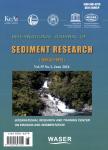Phosphorus fractionation and release characteristics of sediment in the Saemangeum Reservoir for seasonal change
Phosphorus fractionation and release characteristics of sediment in the Saemangeum Reservoir for seasonal change作者机构:Jeongeup Industry-Academic Cooperation Support Center Chonbuk National University Jeollabuk-do Provincial Covernment Department of Environmental Engineering Chonbuk National University
出 版 物:《International Journal of Sediment Research》 (国际泥沙研究(英文版))
年 卷 期:2018年第33卷第3期
页 面:250-261页
核心收录:
学科分类:0709[理学-地质学] 0819[工学-矿业工程] 08[工学] 0818[工学-地质资源与地质工程] 0708[理学-地球物理学] 0903[农学-农业资源与环境] 0815[工学-水利工程] 0816[工学-测绘科学与技术]
基 金:supported by the Jeollabuk-do Project for the water quality conservation of the Saemangeum Reservoir partly supported by the National Research Foundation of Korea with grants (NRF-2015R1D1A3A03020597) from the Ministry of Education
主 题:Algal bloom Fractionation Phosphorus Water management Release Sediment
摘 要:Periodical algal blooms result in deposition and release of phosphorus(P) from the sediment into the water. Therefore, during seasonal changes when algal particles begin to settle to the bottom, understanding the behavior and distribution characteristics of the P in sediment is the most important key to manage the water quality of the Saemangeum Reservoir. In this study, the variation of water quality and sediment composition including chlorophyll-a(Chl-a) and P was investigated to determine the interaction between water and sediment. The study focused primarily on algal particle sedimentation that affects the P release and mineralization of sediment. The Chl-a concentration in water showed a sharp decline in October when the algae began to die in the fall, and afterward the concentration of chemical oxygen demand(COD) and total P(TP) in the sediment increased due to the sedimentation of decaying algal particles in *** the same period of time, the readily bio-available P(RAP) in the sediment showed a drastic increase in the upper region where the Chl-a concentration of water was high. In sequence, the high RAP zone shifted from the upper region to the lower region in the early winter. The RAP shift was considered to be derived from the physical flow of the overlying water from which the decomposing algae settled on the surface of the sediment. The Saemangeum Reservoir was constructed recently; therefore, all the types of inorganic P fractions except soluble reactive phosphorus(SRP) that exist on the bottom surface of the lake and the marsh’s sediment layer were not sufficient to significantly influence the overlying water. On the other hand, the released P from the algae was distinct and sensitive to the seasonal change. In conclusion,the algal particle sedimentation was important to control eutrophication rather than P release from the mineralized inorganic P of the sediment surface layer in the Seamangeum Reservoir.



